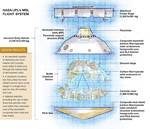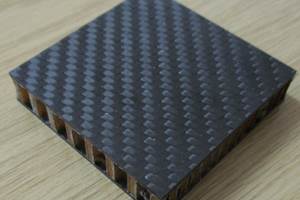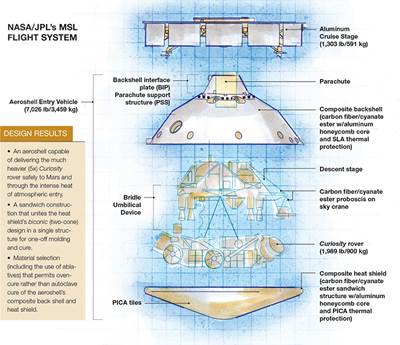The Curiosity Mars rover: Descent stage composites
Apart from the aeroshell that protected the Curiosity rover during its months in space and Mars descent sequence, only a few other parts of the mission’s descent stage were made from composite materials. Here, HPC identifies and describes them.
Apart from the aeroshell that protected the Curiosity rover during its months in space and Mars descent sequence, only a few other parts of the mission’s descent stage were made from composite materials. (For details of the aeroshell’s composites design, see “Composites carry the Curiosity rover to a safe Mars landing” under Editor’s Picks,” at top right.) Eric Oakes, a materials engineer in NASA’s Jet Propulsion Laboratory (JPL). Provided the following data:
The proboscis on the skycrane features a set of structural M55J/BCTA-1A prepreg tubes that held the ground sensing radar on the skycrane. These tubes were bonded to primed titanium end-fittings with EA 9392 room-temperature cure paste adhesive, supplied by Henkel Aerospace (Bay Point, Calif.), which offers exceptional shear strength at high temperatures.
The parachute closeout cone lid is a sandwich construction, with a circular (36-inch/91.4-cm diameter, 0.125-inch/0.32-cm thick) aluminum vented honeycomb core panel bonded between M55J/BTCy-1A faceskins. The lid was installed at the top of the back shell. During descent, the parachute canister “shot out right through the lid,” Oakes says. The lid design needed to meet launch loads and changing pressure loads — “but not be too strong to slow down the velocity of the parachute canister, since that could risk interference with the opening of the parachute.” Further, when it pushed through the back shell, the lid had to “come out cleanly and fly away,” Oakes says, “so the piece was not floating around to possibly go through the parachute or damage any other parts.”
On the rover itself, composites were employed to build three antenna radomes (see image, at right), using TenCate Advanced Composites’ (Morgan Hill, Calif.) Astroquartz quartz fiber/BCTy-1A cyanester prepreg, which Oakes describes as having a “heritage from the Deep Impact 2005 mission to a comet and beyond.” The material was ideal, he notes. “We know the values are constant, we know the loss tangent of that material, we know what its properties are.”
Further, the heat exchangers that control the rover’s temperature on Mars are also sandwich constructions. Hexcel’s trademarked HexWeb HRH 10 Nomex aramid fiber/phenolic composite honeycomb panels — 0.125-inch/3-mm thick, 6 lb per ft3/96 kg per m3—are bonded between 7075-T73 aluminum alloy facesheets. Reportedly, these panels can withstand a temperature gradient of 201°C/394°F with temperature extremes ranging from a low of -111°C/-168°F on the outside to 90°C/194°F on the inside. The honeycomb cells needed to be vented, but the core material was not supplied in that form, so Oakes “had a tool made with evenly spaced knife blades to cut a small slit in the tops of each of the honeycomb cells.”
After the honeycomb core was bonded to the inside faceskins, Oakes says that JPL “crushed a product called Aerogel into the honeycomb” to block heat from passing through the cells. Invented in the 1930s and refined by NASA, Aerogel is the lightest and lowest density solid known to exist, weighing a mere 0.00011 lb/in3. After the honeycomb cells were filled, the outside aluminum skin was bonded onto the now-vented core. Aluminum tubes bonded to the panels carried Freon refrigerant made by DuPont Chemicals & Fluoroproducts (Wilmington, Del.) through the heat exchanger.
The panels were bolted directly to the rover chassis and a multi-mission Radioisotope Thermalelectric Generator (MMRTG), the nuclear source for the rover’s energy, was installed between the panels, bolted to the rover but not connected to the panels.
Related Content
XlynX Materials BondLynx and PlastiLynx for low surface energy PP, PE substrates
Award-winning Xlynx materials use breakthrough “diazirine” technology to boost bond strength up to 950% as adhesives, primers and textile strengtheners.
Read MoreSyensqo introduces AeroPaste 1003 aerospace adhesive
Two-part room-temperature paste increases high-rate assembly and joining efficiencies when bonding metallic and composite parts.
Read MorePittsburgh engineers receive $259K DARPA award for mussel-inspired underwater adhesion
The proposed META GLUE takes inspiration from hydrogels, liquid crystal elastomers and mussels’ natural bioadhesives to develop highly architected synthetic systems.
Read MorePRF Composite Materials introduces primer, adhesive films
Novel RFA570 eXpress cure adhesive film and RF Primer are compatible with PRF’s full range of epoxy prepregs formulations.
Read MoreRead Next
Composites carry the Curiosity rover to a safe Mars landing
From launch to touchdown, composites performed in flight and stuck the landing!
Read MoreVIDEO: High-volume processing for fiberglass components
Cannon Ergos, a company specializing in high-ton presses and equipment for composites fabrication and plastics processing, displayed automotive and industrial components at CAMX 2024.
Read MoreDeveloping bonded composite repair for ships, offshore units
Bureau Veritas and industry partners issue guidelines and pave the way for certification via StrengthBond Offshore project.
Read More

























